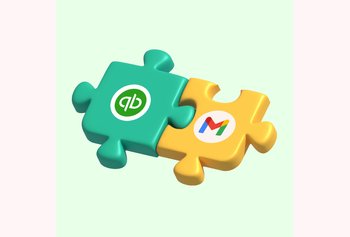10 Web-Based Help Desks for 2025
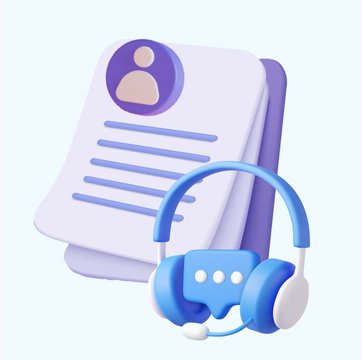
Table of contents
For customer support teams, using a web-based helpdesk is not just about keeping pace with technology. It’s about leveraging the web’s power to offer seamless and accessible support across multiple channels.
Beyond helping support teams provide real-time support, web-based helpdesks streamline internal support operations and automate several tasks – all of which contribute to higher team efficiency.
In fact, an added advantage with using such a help desk is that they help you deliver seamless support irrespective of whether your agents work remotely or out of the same office.
In this article, we discuss some of the popular web-based help desk tools in the market. We focus on their standout features and pricing.
Table of Contents
- What is A Web-Based Help Desk Software?
- Features to Look for in A Web-Based Help Desk
- 10 Best Web-Based Help Desks for Your Customer Support Team
- How Are Web-Based Help Desks Different from On-Premise Help Desks?
- Benefits of Web-Based Help Desk Software
- Wrapping Up
What is A Web-Based Help Desk Software?
A web-based help desk is a software that helps businesses manage and resolve customer queries over the internet. It offers features such as ticket management, multi-channel support, automations, and more.
Since a web-based help desk is cloud-based, it does away with the complexities of legacy help desk systems and are relatively more scalable and flexible.
For instance, say you’re running an ecommerce business and experience a surge in customer queries during the holiday season.
Seeing as it is the holidays, it is likely that a good chunk of your team members are working remotely. In such a scenario, a web-based help desk can help your team manage this influx of inquiries without having to be tied to their desks. It can even be used to understand your teammates’ availability and assign customer tickets based on when your agents are online.
The self-service features that web-based help desks offer are key to helping customers troubleshoot issues on their own. This limits ticket volume and also reduces burnout amongst your agents.
Features to Look for in A Web-Based Help Desk
Choosing the right web-based help desk is crucial for efficient customer support. Here are the things you should look for.
- Ticket management: Support agents can create, assign, and track customer tickets from a centralized dashboard with a web-based help desk.
- Multi-channel support: Engage with customers across channels such as email, live chat, phone, and social media.
- Knowledge base: Direct customers to help articles, how-to-guides, tutorials, and videos to help them find answers to their queries and troubleshoot issues using a knowledge base or help center.
- Automation: Streamline repetitive tasks such as ticket routing and tagging. Reduce the burden on your agents and enable them to focus on more complex tasks.
- Reporting and analytics: Gauge actionable insights and track key metrics such as CSAT, first response time, ticket volume, etc. to understand what’s working and what’s not in your support process.
- Integrations: Ensure that your web-based help desk integrates seamlessly with the different systems in your tech stack such as CRMs, sales intelligence tools, and others.
You Might Also Like: 12 Best Email Ticketing Systems for Customer Support
10 Best Web-Based Help Desks for Your Customer Support Team
Here is a quick comparison of the top 10 web-based help desk systems in the market.
| Web-Based Help Desk | Features | Pricing |
|---|---|---|
| Hiver | Multichannel support Notes and @mentions for collaboration Automations Email management | Starts at $19 per agent per month |
| Zoho Desk | Zoho Desk AI – Zia Work Modes Reports and Dashboards | Starts at $14 per agent per month |
| BoldDesk | Ticketing system Task management Private notes and tickets Automation | Starts at $10 per agent per month |
| HelpDesk | Ticket summary Analytics Ticketing personalization | Starts at $29 per agent per month |
| Zendesk | Agent workspace Routing and intelligence Workforce management Zendesk AI | Support plan starts at $19 per agent per month Suite plan starts at $55 per agent per month |
| Frehdesk | Parent child ticketing Freshdesk AI – Freddy Collaborators | Starts at $15 per agent per month |
| Help Scout | Beacon Automation Reporting and analytics | Starts at $20 per agent per month |
| Kayako | Ticketing system Customer journey mapping Live chat | Custom pricing |
| HubSpot Service Hub | Customer portal Omnichannel messaging Shared inbox | Starts at $450 per month |
| HappyFox | Ticket management Multichannel support Knowledge base Automation | Agent based pricing starts at $26 Pricing for unlimited agents starts at $1149 per month |
Below is a comprehensive overview of some of the best web-based help desk solutions.
1. Hiver
If you’re someone looking for a web-based help desk that is easy to use and is not much of a hassle, then Hiver is the answer.
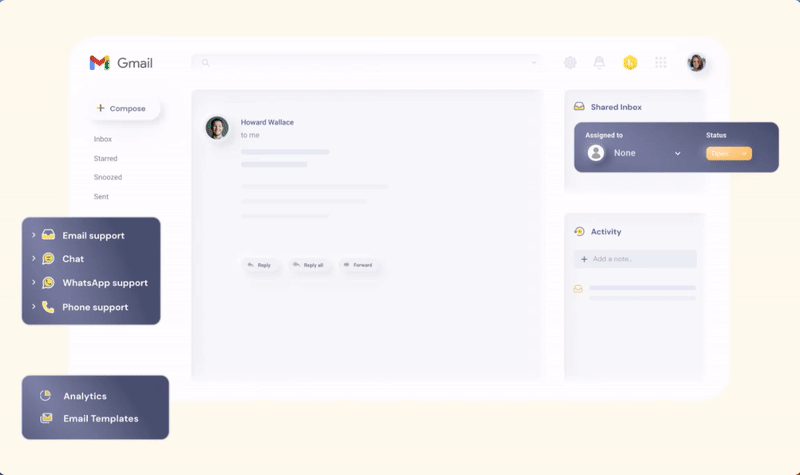
It is an incredibly easy-to-use help desks software that offers a wide range of features to help you manage customer interactions with ease. Teams can streamline their customer support process by enabling seamless communication with internal collaboration features and automating repetitive tasks.
What stands out in particular is Hiver’s 24/7 vendor support that ensures user queries are addressed promptly with minimal downtime.
Key Features
- Multi-channel Support: Interact and engage customers across channels such as email, live chat, WhatsApp, and knowledge base. This makes it easier for you to reach out to customers on their preferred channels.
- Ticket Management: Every incoming email is converted into a ticket and assigned to a support agent. Every query has a dedicated owner, ensuring that nothing falls through the cracks.
- Collaboration: Team collaboration has never been easier than with Hiver’s Notes. It is present alongside every email and is the easiest way for your team members to work together on customer queries. Use @mentions to add a team member to a Note and write a message. They will be notified in real-time and can respond with their insights.
- Automations: Say goodbye to repetitive tasks and let your agents focus on what matters the most. You can set up automations so that incoming queries are routed to agents based on their skills or workload. You can also use automations to take care of tasks like closing unimportant emails and categorizing incoming queries.

Pricing:
Hiver has a three tiered pricing model with affordable options for small and medium businesses. The pricing starts at $19 per user per month. You can also sign up for a free 7 day trial.
2. Zoho Desk
Zoho Desk is another affordable web-based help desk option, especially if you’re a growing organization.
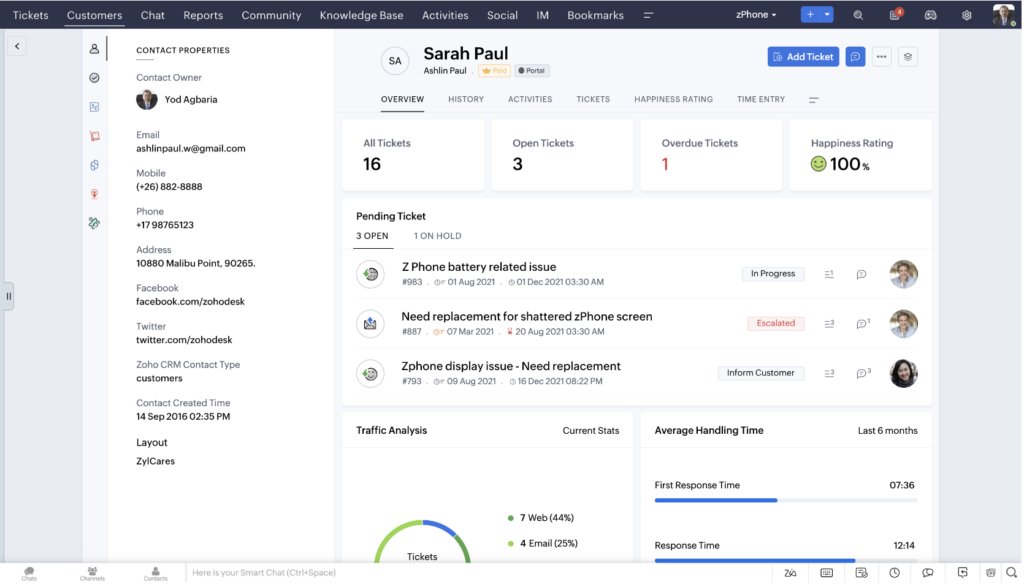
What makes it attractive is the Zoho Desk Express Plan that you can avail at just $7 per user per month. It includes basic functionalities for teams just starting with their customer support function.
Like with other help desks, Zoho Desk also offers robust features for ticket management, instant messaging, web forms, and sentiment analysis.
Key Features
- Zia: Zoho Desk’s AI – called Zia – can be used to deliver instant customer support. It can understand the context of a query and surface the most relevant insights from your knowledge base for your customers. Zia is also equipped with sentiment analysis that allows the AI to analyze a customer’s need or intent using sentiment analysis to better understand the context of every ticket.
- Work Modes: A great feature for improving agent productivity. With Work Modes, open tickets are automatically organized according to priority, ticket type, customer type, etc. This way the most important customer queries are addressed first.
- Reports and Dashboards: Use Zoho Desk’s detailed reporting features to keep track of your team’s performance and to monitor customer service metrics like average handling time, first response time, and resolution time. Get actionable insights into what’s working and identify areas for improvement in your support strategy.
Pricing:
Zoho Desk’s pricing starts at $14 per user per month and goes up to $ 40 per user per month. You can also test out the platform with their free 15 day trial
3. BoldDesk
BoldDesk offers all the features of a customer service solution but at SMB friendly pricing.
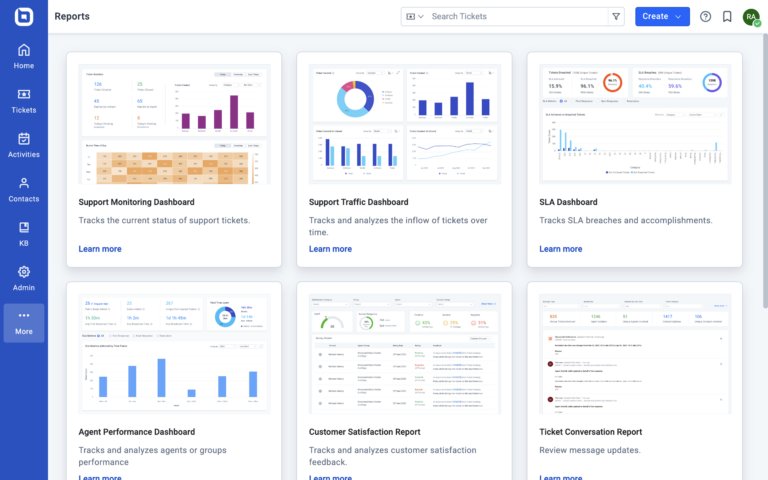
BoldDesk is a simple to use solution that employs AI to help support teams streamline customer experience. It also provides customizable features and a number of integrations, making it an excellent choice for any platform that is looking to centralize and optimize customer support. The platform is quite affordable with just $10 for 3 agents.
Key Features
- Ticketing system: Create tickets for customer queries from any channel and route it to the appropriate agent with the right skill set. Use in-built tags and features to categorize and prioritize tickets so your agents know exactly what they need to work on.
- Task management: Break down complex tickets into multiple sub-tasks. Assign sub-tasks to different agents so that tickets are resolved faster but with lesser load on your support agents.
- Collaboration: Collaborate with teammates using BoldDesk’s private notes. Get inputs from your colleagues whenever you need help resolving a customer ticket.
- Automation: Create custom workflows to automate repetitive manual tasks. Use automation for tasks like updating ticket properties, assigning queries to agents, and adding tags to tickets.

Pricing:
BoldDesk has two pricing plans each with three tiers. The agent-based plan starts at just $25 and goes up till $75 per agent per month. They also have a plan for unlimited agents that starts at $799 per month.
BoldDesk offers a 15 day free trial and even a 30 day money-back policy in case you’re not happy with the platform.
4. HelpDesk
If you’re looking for a web-based help desk that doesn’t come with complexities of multiple pricing plans, then HelpDesk is the right choice for you.
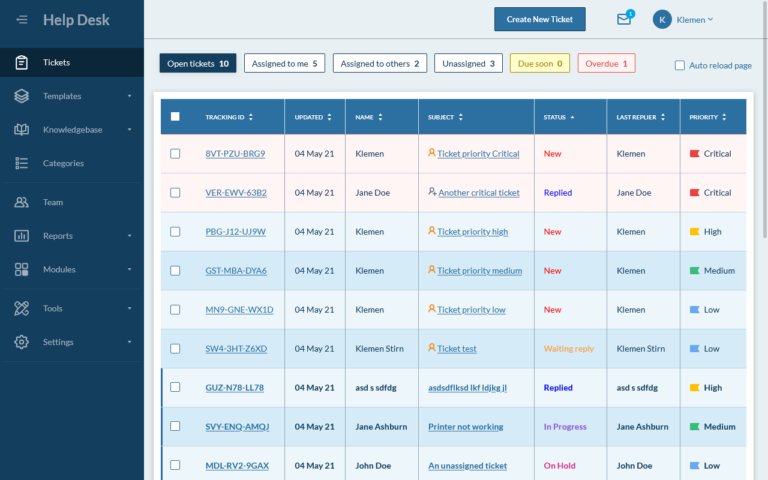
This is because HelpDesk has a single pricing plan that comes with most of the features you would need in a customer service platform.
HelpDesk is again, a good option for individuals and small businesses because of it’s relatively simple and affordable pricing.
Key Features
- Ticket summary: HelpDesk’s AI picks up the most relevant information from a customer ticket and then summarizes them for your ease. Your agents get a brief overview of the customer query, allowing them to come up with faster responses.
- Analytics and reporting: Choose from 6 different report types to track ticket satisfaction, first response time, resolution time, solved and closed queries, etc. Keep track of the metrics that matter and identify any gaps in the support process.
- Ticketing personalization: You can add a touch of personalization to your communication by leveraging HelpDesk’s personalization features. Using this, you can create custom signatures, set up a custom domain and reply address, and even tailor the visual appearance of your emails.

Pricing:
HelpDesk offers a team plan priced at $29 per user per month and includes most of the features that your business would need from a web-based help desk solution. The platform has a custom pricing plan for Enterprises that includes a few additional advantages when it comes to product support.
HelpDesk offers a free 14 day trial.
5. Zendesk
Zendesk for service is a cloud-based help desk that can be a good option for large businesses with complex support needs.

Although Zendesk’s pricing plans are slightly too complicated and the platform itself takes some time to set up, there are some standout features that can streamline support operations for large companies and enterprises.
Key features
- Agent workspace: Essentially a single dashboard from where your agents can manage customer tickets, collaborate, and get complete context into customer queries. This is useful in that your agents don’t have to switch between multiple applications to get their work done.
- Routing and intelligence: Zendesk keeps things moving by taking note of details like agent availability, workload, and skill set. Incoming tickets are then categorized based on their priority, customer type, and urgency and routed to the appropriate agents according to the smoothest path to resolution.
- Workforce management: Zendesk’s AI can track agent activity and attendance. Use this data to predict staffing needs and prepare for personnel shortages. You can also automate agent scheduling and allocate your staff based on their workload, expertise, or shift.
- Zendesk AI: Zendesk’s bots are trained on common issues with the help of past conversations. Any time a customer raises a query, the bots can detect the intent of the conversation and offer relevant responses. In case the bot cannot answer the query, it immediately hands it off to the right agent.

Pricing:
Zendesk’s Suite plan starts at $55 per agent per month and goes up till $115 per agent per month.
Zendesk has a free 14 day trial.
You Might Also Like: Hiver vs Zendesk: A Comparison Guide
6. Freshdesk
Freshdesk’s intuitive ticketing system makes it easy for your agents to deliver personalized support at scale.
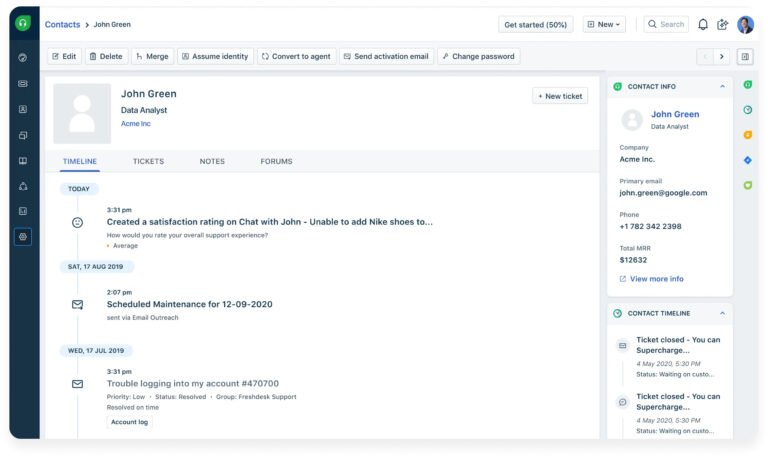
The best part about Freshdesk’s web-based help desk is that there is an affordable option for businesses of all sizes. For example, there is a forever free plan for a team of 10 agents that includes basic features such as ticketing, knowledge base, internal collaboration features, and 24/7 email support.
Freshdesk offers some standout features that make it easy for your teams to effectively engage with customers.
Key features
- Parent-child ticketing: Break down a complex customer query (parent ticket) into several smaller sub-tasks (child ticket). Each ticket can then be assigned to a different agent. This is super useful in tackling complex queries that have multiple action items which in turn speeds up your resolution time.
- Freddy AI: Freshdesk’s AI, Freddy, can be used to deliver contextual and accurate answers to customer queries. The bot can fetch relevant information from your knowledge base and then instantly display them to customers. Freddy can also analyze past tickets and automatically suggest ticket fields any time a new query is raised. This saves agents from having to manually categorize and prioritize tickets. Aside from this, Freddy can scan tweets for mentions of your business or customer complaints.
- Collaborators: Effortlessly collaborate with both internal and external stakeholders to resolve queries more quickly and efficiently

Pricing:
Freshdesk’s pricing starts at $15 per agent per month and goes up till $69 per agent per month. The platform also offers a free 21 day trial.
You Might Also Like: Why You Should Choose Hiver Over Freshdesk: A Detailed Comparison
7. Help Scout
If you want a web-based help desk that brings together shared inboxes (email support),help center, and live chat to elevate your customer interactions — consider Help Scout.
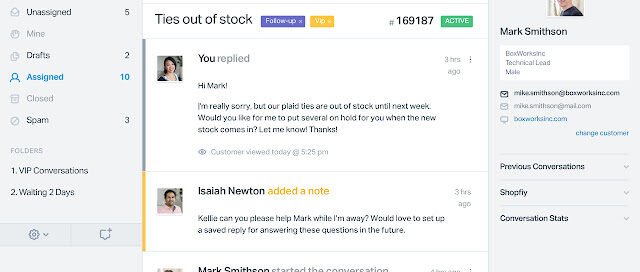
It is a relatively easy-to-use platform where agents can collaborate on customer queries, assign conversations, and leave internal notes.
Help Scout’s features make it easy for you to stay on top of your emails and personalize your customer communications.
Key Features
- Beacon: Help Scout’s Beacon feature allows businesses to embed a help widget directly on their website, enabling customers to search for answers, start conversations, and submit inquiries without leaving the site. This provides a seamless support experience and reduces friction for customers.
- Automation: Streamline repetitive tasks and workflows. Setup rules and triggers to automate ticket routing, assignment, and follow-ups, saving time and effort for your agents.
- Reporting and analytics: Help Scout provides robust reporting and analytics tools that allow businesses to track key support metrics, measure team performance, and gain insights into customer satisfaction. This data-driven approach enables businesses to make informed decisions and continuously improve their support operations.

Pricing:
Help Scout’s pricing plan starts from $75 per month and goes up to $850 per month. It features an all-in-one pricing where users get access to unlimited shared inboxes and AI. There is also a 15-day free trial.
8. Kayako
Kayako is a versatile web-based help desk software that enables businesses to manage customer inquiries and support tickets efficiently.
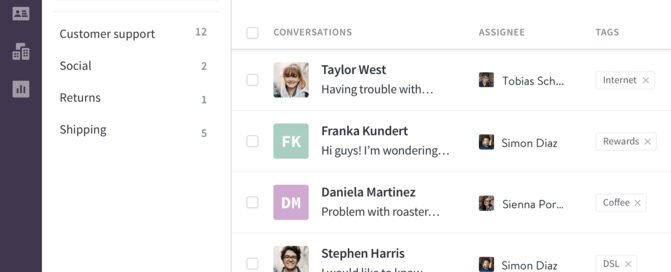
Kayako’s pricing and key features makes it an affordable option for SMBs. Features such as live chat and self-service are useful as they help customers get solutions quickly – they aren’t kept waiting for a response as in the case of email support.
Aside from these, Kayako has several other features which makes it a great choice for businesses looking to streamline customer support and improve agent productivity.
Key Features
- Ticketing System: Kayako’s ticketing system allows support teams to create, assign, prioritize, and track support tickets, ensuring timely resolution and effective communication with customers. Agents can collaborate on tickets, add internal notes, and track the status of each ticket throughout its lifecycle.
- Customer journey: Map out your customer’s journey and get the complete overview of every interaction a user has with your brand. This allows you to identify areas of friction for the customer – be it during a purchase or while navigating your website – and offer proactive support.
- Social: Communicate with your customers across social media platforms. Support teams can monitor and respond to customer comments on apps like Twitter and Facebook. Get a holistic view of all social media platforms in one dashboard.

Pricing:
Kayako’s cloud offering includes all the features you would require in a web-based help desk. This is perfect for small and growing teams since the pricing is customized according to your support requirements.
Kayako offers a free 14 day trial
You Might Also Like: 10 Kayako Alternatives for 2025
9. HubSpot Service Hub
In case you’re already using HubSpot’s CRM, then opting for Service hub – their helpdesk software – is a good decision.
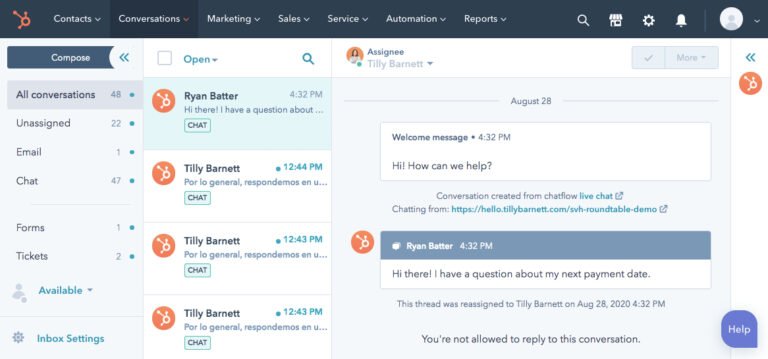
Service Hub makes it easy for support teams to manage customer tickets and respond to queries on time. It brings multiple features – shared inbox, live chat, and feedback surveys amongst others – into one single dashboard.
Key features
- Customer portal: A dedicated space for customers where they can easily access knowledge base resources, FAQs, and other resources. It can be deployed on your website or mobile application to help customers troubleshoot common issues on their own. Customers can even raise tickets if they are not able to find answers. The best part is that the customer portal can be implemented even by non-technical users who are not familiar with programming or coding languages.
- Omnichannel messaging: Provide a unified experience for your customers across channels such as phone, live chat, email, and social media. This ensures that customers can switch between channels without losing the context of their conversation with your support team.
- Shared inbox: A free shared inbox that unifies conversations from live chat, Facebook Messenger, team emails, and chatbots. Teams can view and reply to conversations assigned to them via intelligent routing. This way every customer query receives a response.

Pricing:
HubSpot Service Hub’s pricing starts at $450 per month and goes up to $1200 per month. You can also sign up for a free 14 day trial.
10. HappyFox
HappyFox is an affordable web-based help desk that offers features such as task management, canned actions, and SLAs that make offering customer support a breeze.
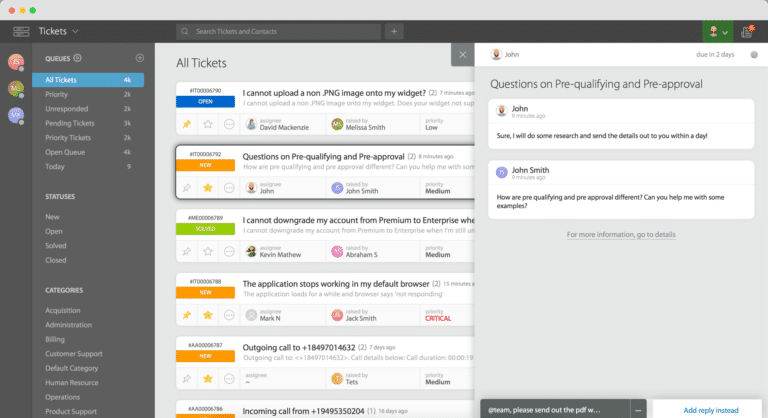
With HappyFox, you can segregate customer tickets into categories such as ‘High Priority’, ‘Pending’, and more. This way support agents always have complete visibility into their workload.
HappyFox has a relatively simple interface and its standout features are useful for teams across industries such as travel, retail, education, non-profits, and others. Its users say that HappyFox is much easier to use than other ticketing systems such as Salesforce or Zendesk
Key features
- Ticket Management: A comprehensive ticketing system that allows businesses to efficiently manage customer inquiries from a centralized dashboard. Agents can create, assign, prioritize, and track tickets, ensuring timely resolution and effective communication with customers.
- Multi-channel Support: Equip your agents to engage with customers across multiple communication channels, including email, live chat, social media, phone, and self-service portals.
- Knowledge Base: Create and manage help articles using HappyFox’s knowledge base feature. This helps customers find answers to their questions and troubleshoot common issues on their own. This reduces the workload on support teams and empowers customers to find solutions independently.
- Automation: HappyFox offers powerful automation capabilities to streamline repetitive tasks and workflows. Businesses can set up rules, triggers, and workflows to automate ticket routing, assignment, escalation, and follow-up, saving time and improving efficiency.

Pricing:
HappyFox has two different types of pricing – one is an agent-based pricing while the other is meant for unlimited agents.
The agent based pricing starts at $26 per user per month and goes up till $64 per user per month. The plans for unlimited agents start at $1599.
HappyFox also offers a free 14 day trial.
You Might Also Like: Top 10 HappyFox Alternatives
How Are Web-Based Help Desks Different from On-Premise Help Desks?
Let’s take a look at some key differences between web-based help desks and on-premise help desks
Deployment
- Web-based help desks are hosted on the vendor’s services and are accessed via the internet. You can use the help desk from your browser or mobile app without having to worry about infrastructure.
- On-premise help desks are installed in the organization’s physical location. They need separate infrastructure and maintenance – including security, updates, and backups.
Accessibility
- Web-based help desks can be accessed from anywhere. All you need is an internet connection. This makes it easier for teams working remotely to offer seamless customer support.
- On-premise help desks can only be accessed from the organization’s internal network. Remote access is limited and may require additional permissions and configurations.
Cost
- Web-based help desks do not require any infrastructure which means lower upfront costs. They work on a subscription model where users can pay for the features they need on a recurring basis.
- On-premise help desks have higher upfront costs for setting up the infrastructure, purchasing software licenses, maintenance, etc.
Scalability
- Web-based help desks can be easily scaled as the business grows. You can simply upgrade to a higher plan as the number of users increases.
- On-premise help desks are hard to scale since the infrastructure is already set up for a specific number of users. Scaling up may mean additional infrastructure and licensing costs. This can prove to be expensive.
Benefits of Web-Based Help Desk Software
Implementing a web-based help desk can have several benefits for your business. Here is how they impact the end customer experience and internal support processes.
- Accessibility: Web-based help desks can be accessed from anywhere since they are cloud-based. This means it is easier for remote teams to access tickets and respond to queries promptly.
- Scalability: Your help desk can easily scale as your business grows without the need to invest extensively in hardware or physical infrastructure.
- Cost-effectiveness: One of the benefits of using a web-based help desk is that they operate on subscription-based models. This means that you can invest in features that are most important to you without any upfront capital expenditure.
- Efficient team collaboration: Web-based help desk tools offer collaboration capabilities that make it easier for teams to work together on customer queries and come up with accurate resolutions.
Wrapping Up
We’ve outlined some of the popular web-based help desks in the market and how they can benefit your business. However, choosing the right web-based help desk solution can be overwhelming, which is why it is important to have a clear understanding of what you need in your help desk.
Some of the things you need to consider are:
- Features and functionality
- Ease of use
- Scalability
- Budget
- Integration capabilities
Keeping these factors in mind, you can narrow down a help desk solution that not only aligns with your business objectives but also helps you elevate your customer service.













